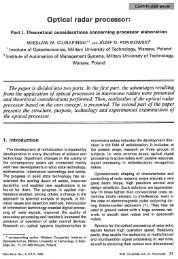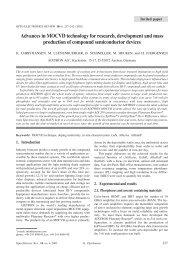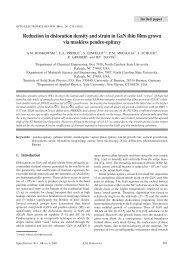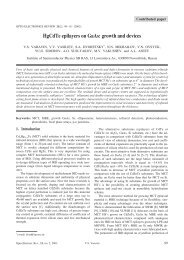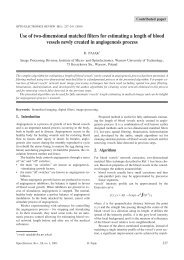InGaAs for infrared photodetectors. Physics and technology
InGaAs for infrared photodetectors. Physics and technology
InGaAs for infrared photodetectors. Physics and technology
Create successful ePaper yourself
Turn your PDF publications into a flip-book with our unique Google optimized e-Paper software.
Contributed paperFrom Eq. (6), the quantum efficiency at the certain advalue is maximised whenR-2d= R ea . (7)1 2Figure 11 shows the maximum h max as a function of ad<strong>for</strong> various R 2 values. To attain the highest h, near unity R 2is desirable. For conventional detectors, without the cavityeffect (R 2 = 0), quantum efficiency higher than 90% can berealized only <strong>for</strong> a thick (> 2 µm) active layer (curve R 2 =0in Fig. 11). For RCE detector, when R 2 = 0.99, the h > 90%can be obtained <strong>for</strong> < 0.05-µm thick layer (a =10 4 cm –1 ).This fact is very helpful towards improving the high-speedper<strong>for</strong>mance of detectors reducing the electronic transit time.Fig. 12. Optical field distribution in RCE detector as a function ofwavelength <strong>and</strong> position. Top <strong>and</strong> bottom mirrors are 5 <strong>and</strong> 15periods GaAs/AlAs. Cavity is optimised <strong>for</strong> the wavelength of0.9 µm (after Refs. 8 <strong>and</strong> 9).Fig. 10. Wavelength dependence of quantum efficiency <strong>for</strong> RCEdetectors (after Ref. 7).The spatial distribution of the optical field inside thecavity is a specific feature of the cavity. It arises from thest<strong>and</strong>ing wave <strong>for</strong>med by the two propagating waves. Acalculated distribution of the optical field is presented inFig. 12. It follows that h, which is derived from the powerabsorbed in the active region, depends on a position of theactive region in the optical field. In order to obtain maximumvalue of the detector efficiency, the active regionshould be placed in a wave antinode position.The st<strong>and</strong>ing wave effect is conveniently included inthe calculation of as an effective absorption coefficient,i.e., a eff = SWE × a, where SWE is the st<strong>and</strong>ing wave coefficient.The SWE coefficient is an explicit function of thecavity properties [8,9].Earlier, we confined our consideration of h to a normalincidence. The changes of a detector quantum efficiencyversus angle incidence are presented in Fig. 13. The calcu-Fig. 11. Maximum quantum efficiency as a function of normalisedabsorption coefficient (after Ref. 7).Fig. 13. Changes of h <strong>for</strong> off-angle incidence at l = 1.0 µm <strong>and</strong>l = 1.5 µm <strong>and</strong> different finesses F = 10 <strong>and</strong> F = 20 (after Ref. 7).Opto-Electron. Rev., 12, no. 1, 2004 J. Kaniewski 143



